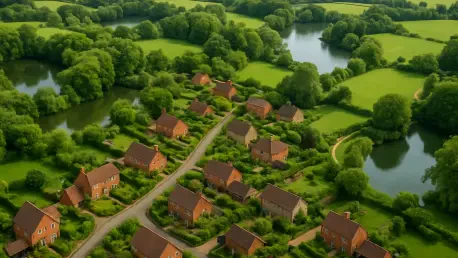I’m thrilled to sit down with Luca Calarailli, a renowned expert in construction with a deep background in design and architecture. Luca’s passion for integrating technology and innovation into the building industry makes him the perfect person to discuss the complex intersection of housing development and environmental policy in the UK. Today, we’ll explore the findings of a recent Environmental Audit Committee report, diving into the balance between the government’s ambitious housing targets and the need to protect nature, as well as the broader challenges and solutions within the planning system.
How does the Environmental Audit Committee’s report reframe the relationship between nature and housing growth in the UK?
The report fundamentally challenges the notion that nature stands in the way of building more homes. It argues that viewing nature as an obstacle is a misstep that could derail both housing and environmental goals. Instead, nature should be seen as a vital component of creating resilient, livable communities. The committee emphasizes that protecting habitats doesn’t have to mean fewer homes—it’s about smarter planning and integration. If the government continues to frame nature as a problem, they risk alienating communities and missing their targets by ignoring the real issues slowing down development.
What are some of the deeper issues the report identifies as the true barriers to meeting the government’s goal of 1.5 million homes by 2029?
The report points to a range of systemic problems that have little to do with nature. For starters, unclear and contradictory policies create confusion for developers, leading to delays in approvals and construction. Then there’s land banking, where developers hold onto land without building, waiting for its value to rise, which stalls progress. On top of that, there’s a significant shortage of skilled workers in fields like ecology, planning, and construction. These gaps mean projects can’t move forward efficiently, no matter how much habitat protections are adjusted.
Can you walk us through the government’s Nature Restoration Fund and the committee’s perspective on it?
The Nature Restoration Fund is part of the government’s strategy to balance housing growth with environmental protection. The idea is that developers can pay into this fund to support habitat improvements elsewhere, rather than preserving nature on the specific site they’re building on. It’s meant to offset the impact of development. However, the committee is skeptical about its effectiveness. They worry it might just be a workaround that doesn’t truly address the loss of local ecosystems and could fail to deliver meaningful restoration if the funds aren’t managed properly or prioritized correctly.
How do unclear policies specifically contribute to delays in housebuilding, based on the report’s findings?
Unclear policies create a ripple effect of uncertainty. Developers and local authorities often struggle to interpret conflicting rules, which slows down the planning process. For instance, if guidelines on environmental impact aren’t consistent, projects get stuck in endless revisions or appeals. This lack of clarity can discourage investment and make it harder to get shovels in the ground, ultimately delaying the delivery of much-needed homes.
What are some of the innovative solutions the committee proposes to address these housing challenges without sacrificing nature?
The committee offers a forward-thinking approach. They suggest tackling the skills shortage by investing in training programs for ecologists, planners, and construction workers to build a stronger workforce. They also advocate for incentives to promote carbon-friendly homes, whether through new builds or retrofitting existing ones. Additionally, they recommend boosting the production of green construction materials and adjusting tax policies to favor sustainable building practices. These ideas aim to align housing growth with environmental goals, creating a win-win scenario.
How does the concept of land banking impact the pace of housing delivery, and why is it a concern?
Land banking is a major bottleneck. Developers often buy up land and sit on it, waiting for the market to peak before building. This practice ties up valuable space that could be used for homes right now. The report highlights that it’s a speculative strategy that prioritizes profit over public need, contributing significantly to delays in meeting housing targets. It’s a frustrating barrier because it’s driven by economics rather than any physical or regulatory constraint.
What’s your take on the criticism from environmental groups about the government’s Planning and Infrastructure Bill?
Environmental groups, like many stakeholders, are concerned that the Planning and Infrastructure Bill prioritizes development speed over quality and sustainability. They argue it fails to deliver well-designed, affordable homes while also undermining nature protections by overriding habitat safeguards. Their critique of a “growth-at-any-cost” mindset suggests the government is pushing for economic gains without fully considering long-term environmental or social consequences. It’s a valid concern—rushing construction without a balanced approach risks creating communities that aren’t livable or resilient.
What is your forecast for the future of housing development in the UK if these tensions between growth and nature protection aren’t resolved?
If these tensions persist, I foresee a future where housing targets might be met on paper, but at a steep cost. We could end up with developments that lack green spaces, fail to support biodiversity, and ultimately harm community well-being. On the flip side, continued delays due to policy confusion or skills shortages could deepen the housing crisis. My hope is that the government takes the committee’s recommendations seriously, integrating nature into planning as a core principle rather than an afterthought. Without that shift, we risk short-term gains for long-term losses—both for people and the planet.









